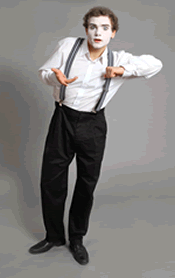- POPULAR ARTICLES
- Thank You Words
- Retirement Wishes
- Face to Face
Nonverbal Communication in Business
Nonverbal communication in business takes place in many settings: during meetings in conference rooms, in offices, at the hallway, during business travel, at restaurants, golf courses, you name it.
 As a start, we will focus now on how people communicate (nonverbally) in an office setting, including a brief discussion regarding business travel.
As a start, we will focus now on how people communicate (nonverbally) in an office setting, including a brief discussion regarding business travel.
Many of the principles of nonverbal communication in business apply to other settings as well.
Nonverbal messages go beyond body language, they also include the messages we send with the clothes we wear, the car we drive, the way we do our hair and so forth. See workplace dress code for more insights on this.
On separate pages we discuss a related subject: body language at work, where you can learn the meaning of the many gestures used in the workplace; and defensive body language, where you can learn how to quickly read the signs of defensive communication .
During Meetings in Conference Rooms
Who sits where at a conference table. People with the highest ranking tend to sit at the head of the table, preferably the end that faces the door. People second in command will tend to sit close the big boss, preferably to his/her right.
In round tables, the highest ranking person will sit in a position that faces the door.
Interruptions will depend on the setting. In formal meetings, people will not interrupt as often as in more informal settings. People will wait for the boss to look at them or to give them the go-ahead to speak.
...and in Offices
In an office, if a manager has a meeting area in addition to his desk, observe how he approaches meeting with you. A manager that meets with you while sitting behind his desk is either trying to keep the meeting short, or tying to assert his authority over you.
Or perhaps he/she doesn’t feel like getting up from his chair at that moment. Don’t give this a whole lot of importance, just observe it.
Looking at their watch. When you are meeting with someone who looks at their watch (or tap their feet) every so often, it’s a sure bet that they need to cut the meeting short. And perhaps go somewhere, or do something else.
To avoid jumping to conclusions, just ask if they need to go and continue the meeting at another time.
Even if you are dealing with something that is critical and urgent, you are not getting the person’s attention anyway, it’s best to continue at another time, when you have the person’s full attention.
Pounding the table or desk: The person is very likely angry. Except in cases when the person is just trying to look stern. It's easy to know if this is the case because the person's face doesn't show anger, it's calm. Always look for congruence between the various verbal and nonverbal cues.
During Business Traveling
People loosen up their norms and rules of behavior and communication while traveling, that is why so many affairs get started in business trips.Two factors contribute to this relaxation of rules: the first factor is that people socialize during or after the conference. This may include social drinking. The second factor is that the setting is removed from the usual office environment, so the line between people's business and private personae become blurred.
If you travel often, you already know what I'm telling you. If you don't travel as often, you may be taken by surprise by this relaxation of norms during business travel. It's tempting to enjoy being free of norms but it's not advisable to let it all hang out. After all, you are coming back to the office on Monday, the structure and rules will be there waiting for you to fit right back in.
During Job Interviews
When you go to a job interview, you could be facing one person or a panel of interviewers. The interviewer(s) will be looking for signs of confidence, relatability, openness, and authenticity in your communication.
Both, the interviewers' and the candidate's body language will be aimed at conveying a specific message.
The interviewers on their end may be trying to appear as approachable, knowledgeable and objective.
The candidate will be trying to appear knowledgeable, trustworthy and likable.
Nonverbal behavior and body language play a big part during an interview. Whether you are an interviewer or a candidate, make sure you read about job interview body language if an interview is in your horizon.
Reading and interpreting nonverbal communication in business is a skill worth mastering for more effective communication in the workplace. To read about examples of non verbal communication at work, click here. Just keep in mind that you have to look at nonverbal cues together with other message cues
Go back to Home Page: People-Communicating




